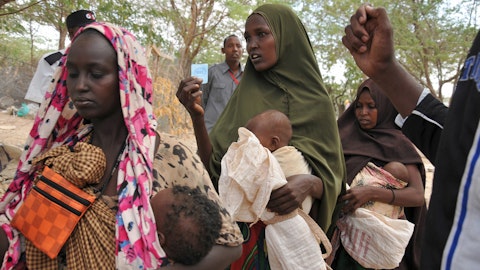This brief article continues the detailed overview we provided of countries heavily funded by foreign aid and how that aid is distributed on a per capita basis. For more details on aid-receiving countries and their needs, read 25 Countries That Receive The Most Foreign Aid Per Capita.
10. Kiribati
Average Per Capita Foreign Aid Received Between 2017-2021: $554
Kiribati is positioned in the central Pacific and has an atoll-based geography that makes it acutely susceptible to climate change. As rising sea levels jeopardize the country’s land and freshwater resources, foreign aid is channeled to construct seawalls, promote sustainable fisheries, and enhance potable water access for the locals.
9. Samoa
Average Per Capita Foreign Aid Received Between 2017-2021: $600
Samoa’s economy, although growing (with the current per capita GDP being $3743), faces threats from natural disasters and external economic shocks. The country receives generous aid from Australia and New Zealand, most of which is spent on addressing its environmental fragility. International partnerships also amplify Samoa’s voice in global forums, particularly in advocating for the concerns of small island developing states.
8. St. Vincent and the Grenadines
Average Per Capita Foreign Aid Received Between 2017-2021: $604
St. Vincent and the Grenadines receives assistance from international partners to ensure its sustainable development, as it faces challenges from small economies of scale and external shocks. Recent volcanic activity has further highlighted the country’s vulnerabilities, necessitating aid for recovery and resilience-building.
7. Dominica
Average Per Capita Foreign Aid Received Between 2017-2021: $671
Dominica, known as the “Nature Isle” of the Caribbean, has historically been vulnerable to severe weather events, and its mountainous landscape makes cultivation difficult. After Hurricane Maria hit Dominica and Puerto Rico in 2017, the role of foreign aid became even more pronounced for island nations. Interestingly, besides the usual foreign aid donors, such as the US, China has also offered large sums in grants and loan projects to Dominica over the years.
6. Micronesia, Fed. Sts.
Average Per Capita Foreign Aid Received Between 2017-2021: $858
The Federated States of Micronesia, an island nation in the western Pacific, faces main challenges, including remoteness, limited resources, and climate vulnerability. Foreign aid from Australia, New Zealand, and the US is instrumental in strengthening the island’s marine resources management. This monetary assistance also enhances connectivity and fosters sustainable economic practices.
5. Tonga
Average Per Capita Foreign Aid Received Between 2017-2021: $1079
January 2022 was a sad month for Tonga, as the nation faced a series of catastrophic natural events, including a volcanic eruption and earthquake. These events caused losses amounting to millions of dollars. The country, already impoverished, didn’t have the resources to overcome such an extreme situation and was largely dependent on foreign aid. The US, Australia, and Britain were the primary supporters during the country’s time of need. The US alone pledged foreign aid of $2.5 million to Tonga following the events to help its people deal with the losses.
4. Marshall Islands
Average Per Capita Foreign Aid Received Between 2017-2021: $2191
The Marshall Islands, an atoll nation in the Pacific, bear a legacy of being a nuclear testing site post-World War II. Sadly, the environmental and health repercussions of this history persist in the islands. Foreign aid, mainly from the US, helps the local governments alleviate these issues, in addition to combating the existential threat posed by rising sea levels.
3. Palau
Average Per Capita Foreign Aid Received Between 2017-2021: $2769
Palau’s environment and economy are closely intertwined with natural hazards and climate crises. The island nation’s commitment to conservation, as evidenced by its large marine sanctuary, necessitates foreign aid to balance ecological goals with economic needs. Aid efforts prioritize fisheries management and sustainable tourism to protect the fragile environment.
2. Nauru
Average Per Capita Foreign Aid Received Between 2017-2021: $2967
Nauru, once prosperous from phosphate mining, has witnessed economic decline as its resources depleted. As the smallest island nation in the world, the country faces constraints in diversifying its economic avenues and doesn’t have the resources to sustain its population. Most of the foreign aid Nauru receives is used for rehabilitating mined-out lands, improving water management, and building capacities in sectors like health and education.
1. Tuvalu
Average Per Capita Foreign Aid Received Between 2017-2021: $3,114
Tuvalu’s elevation, mere meters above sea level, makes it incredibly vulnerable to climate change threats. Therefore, foreign aid serves as a lifeline for the island, helping address the challenges of rising sea levels and ensuring freshwater availability. Beyond environmental concerns, aid also extends to fortifying Tuvalu’s governance and enhancing its ICT (Information and Communication Technologies) capabilities.
Subscribe to the Insider Monkey newsletter for exclusive updates on finance and investment strategies. Dive deep into market analysis and gain an edge in your investment pursuits by entering your email address below. You can also explore 30 Countries With Highest Rates of Population Growth and 20 Countries With Highest Rate Of Down Syndrome.





